07 Feb WIM Interview With Maine DOT Officer Sgt. Chris Rogers
It’s not a secret that overweight vehicles are on the road every day, everywhere in the U.S. Most of these vehicles are aware of their overweight condition but, sometimes, they don’t have a valid permit and they may knowingly try to avoid the scales to thwart the DOT thereby being able to deliver their product to its destination without penalty or delay. Enter Weigh-In-Motion (WIM):
WIM is being utilized in several areas of the country. One is near an entry-point into the state of Maine on I-95, another is on the Brooklyn/Queens Expressway in NYC. (see our article specific to the BQE: Newsletter Oct 25th, 2024 )
In this article, we will be focusing on the state of Maine and how they have been utilizing this technology with very impactful results. We had a chat with Sgt. Chris Rogers of the Maine State Police to help explain how this technology is used and its benefits. Sgt. Rogers has been a Maine state trooper for over 18 years, and of that 18 years he has been a member of the Commercial Vehicle Enforcement for 7 of them.
WIM Scales have been installed at 3 locations/hubs in the south segment of the state. The North and Southbound scales on I-95, and 2 are at support/peripheral scales at Rt.1 and Rt. 236, respectively.
So what is WIM? WIM is a scale technology where scales are installed underground and allow a truck to pass over, at any speed, to gather the weight information of that vehicle. The weights are broken down in detail, by axles and tire, and conveyed to the monitoring DOT officer. There is no weight capacity or speed limitations for these scales, so they are very user friendly. As it relates to enforcement, the DOT officer is able to recognize if the particular truck raises a red flag by appearing to be over on gross, or axle, weights.
The state of Maine has uniquely implemented their network to track and enforce would-be violators by placing their WIM scales on both the main ingress/egress route (I-95) and alternate bypass routes (Rt. 1 and Rt. 236) should the trucks decide to try to elude the main interstate scales. They have experienced notable successes since their initial implementation in 2020.
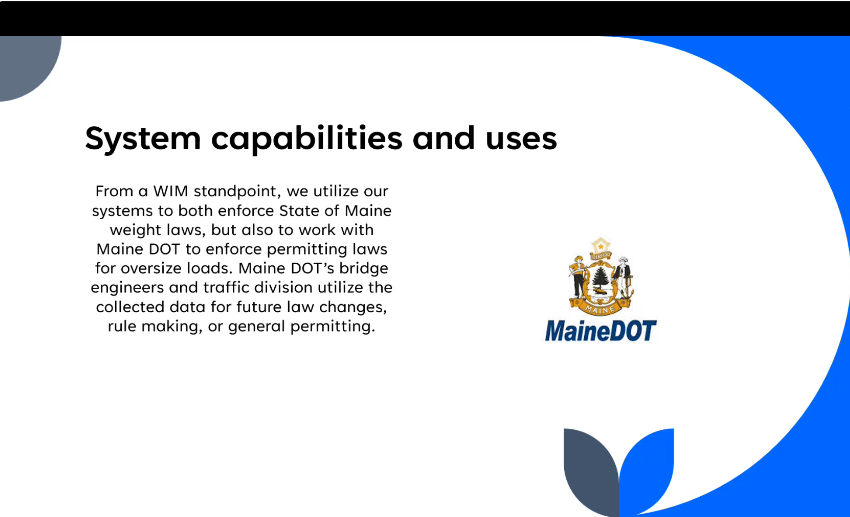
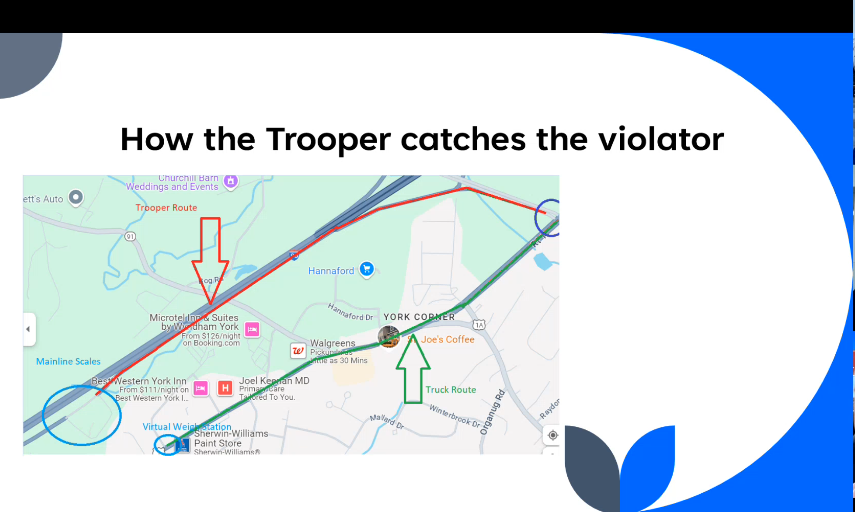 Sgt. Rogers explained that Maine has implemented 3 WIM scale locations. One on the I-95 N/S lanes in southern Maine. And 2 at remote ‘virtual’ locations in order to monitor would-be scale dodgers on Rt.1 and Rt.236. As depicted and explained below, the York/Rt.1 virtual station is used for drivers trying to avoid the Northbound I-95 main scale. In reference to the Rt.236 virtual station, once it was officially installed approximately $9600.00 was utilized by the state for staffing and training. Since the training completion, over $40,000.00 in fines have been written.
Sgt. Rogers explained that Maine has implemented 3 WIM scale locations. One on the I-95 N/S lanes in southern Maine. And 2 at remote ‘virtual’ locations in order to monitor would-be scale dodgers on Rt.1 and Rt.236. As depicted and explained below, the York/Rt.1 virtual station is used for drivers trying to avoid the Northbound I-95 main scale. In reference to the Rt.236 virtual station, once it was officially installed approximately $9600.00 was utilized by the state for staffing and training. Since the training completion, over $40,000.00 in fines have been written.
Here you will see 2 lines being shown. The green line represents a truck taking the Rt. 1(N) route to purposefully avoid the I-95(N) main scale-house. The main scale house will be notified once the truck passes over the Rt.1 virtual scale (no on-site DOT officer is needed). If the truck is overweight and/or illegal, a DOT officer will leave the scale house in order to intercept the truck at the circled point. A roadside inspection ensues, and should the officer deem it necessary he will escort the truck back to the main scale for a full inspection.
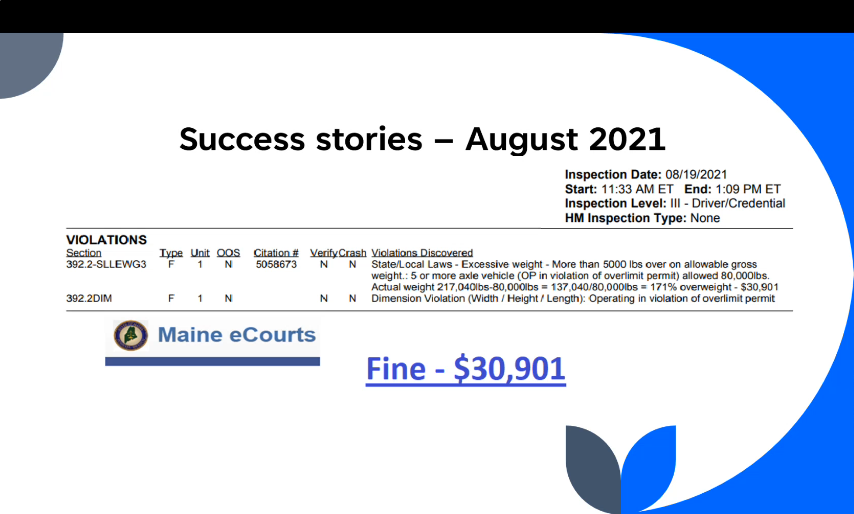
In this example the WIM scale alerted the scale house the truck was grossing 217,040Lbs and was 5000+lbs over on allowable gross. After being escorted to the scale house for a level III inspection, the officer computed the citation based on legal weight, 80,000lbs. and thus the fine was issued on being 137,000lbs (217k minus 80k) over legal limit (or 171%) which resulted in a fine of $30,901.00.
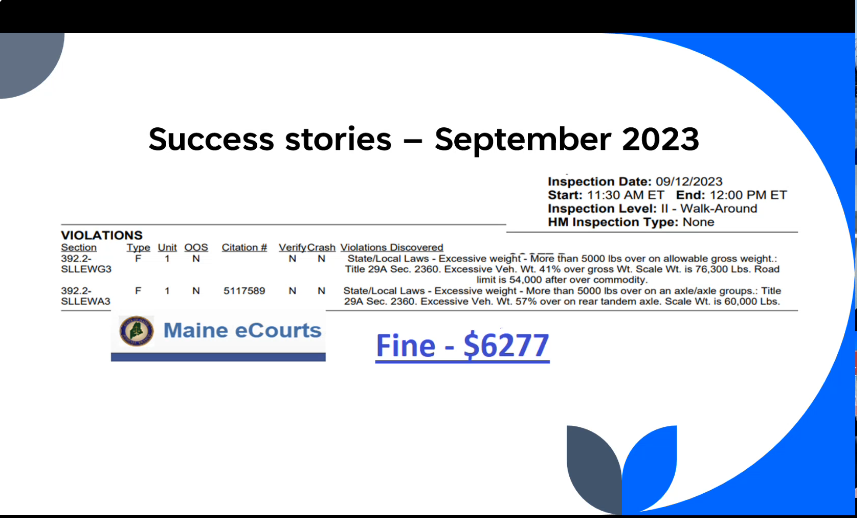
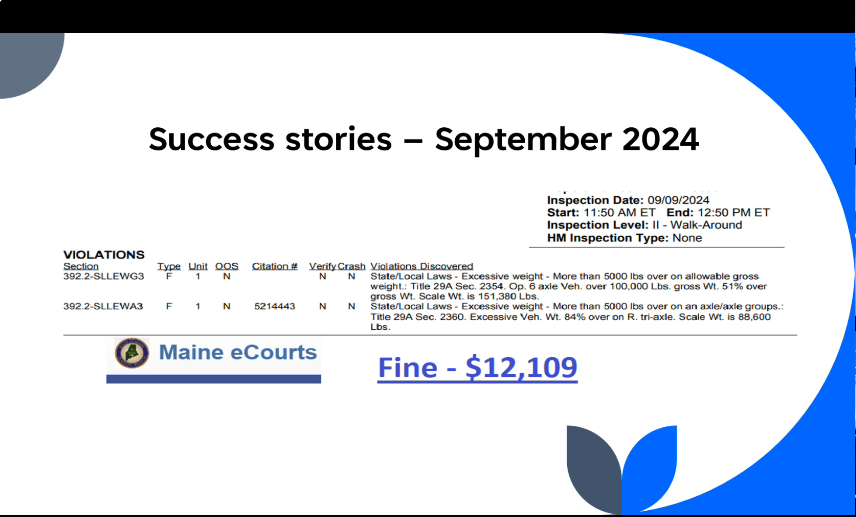
Here you will see this truck was 41% over allowable legal gross weight, and 57% over allowable legal rear tandem weight. According to the WIM scale he grossed 76,300Lbs with 60,000Lbs on his rear tandem axle. The officer intercepted the truck, confirmed the weight provided by the WIM scale was accurate, then issued a fine of $6,277.00 for over gross and over rear tandem weight.
In this last example, the truck crossed the WIM scale showing a gross weight of151,380Lbs as well as a tri-axle weight of 88,600lbs. After verifying the weight, the officer issued a fine of $12,109.00 accordingly.
Permit America has knowledgeable and experienced staff to help you navigate your OD/OW needs here and anywhere else in the U.S or Canada!
Make sure to like/follow our social media pages ![]()
![]() for up to date information on industry changes, closings, restrictions, and all things permitting.
for up to date information on industry changes, closings, restrictions, and all things permitting.



No Comments